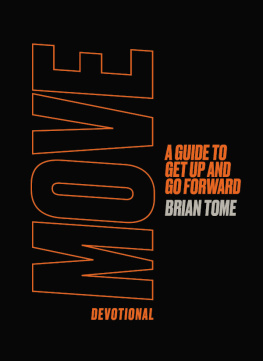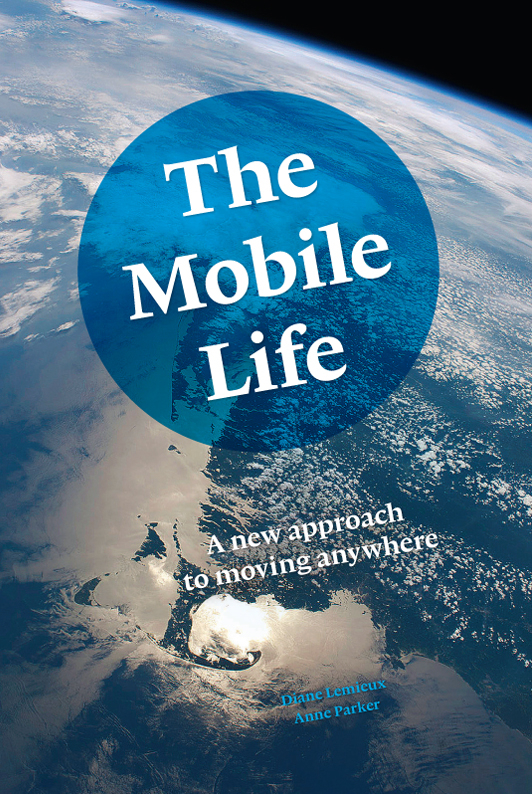Dedication
This book is dedicated to our parents for giving us the experiences and upbringing that made this book possible.
The Mobile
Life
A new approach
to moving anywhere
Diane Lemieux
Anne Parker
Colophon
Copyright 2013, Diane Lemieux Anne Parker
All rights reserved. No part of this book may be reproduced or used in any form without permission in writing of the publisher.
XPat Media
Van Boetzelaerlaan 153
2581 ar The Hague, the Netherlands
Tel. +31(0)70 306 33 10 / +31(0)10 427 10 22
E-mail
Internet www.xpat.nl
Distribution www.scriptum.nl
Cover photo http://visibleearth.nasa.gov
Graphic design Aperta, Jan Johan ter Poorten
Final editing Deborah Valentine
Printing DZS grafik
ISBN 978 90 5594 922 9
Print edition ISBN 978 90 5594 807 9
nur 600, 740
www.themobilelife.eu
Foreword
The modern world is relentlessly, aggressively global and many of its citizens, in response, are necessarily and increasingly mobile. I am one such citizen; in the terminology that this book presents, I have been an expat, a repat, an impat, raising Third Culture Kids and requiring a spouse to trail after my work. Moving back and forth across four continents, weve encountered challenges in many domains cultural, climatic, logistic, culinary, financial, professional and personal. Most of those obstacles we were able to resolve over time, though not necessarily with great efficiency. For us it has been more of a crossing the river by feeling the stones than a systematic, preemptive approach.
Lemieuxs and Parkers pragmatic book provides a handbook for the increasing numbers of people who interact with this modern, global world by embarking on a life of mobility people like me and people like the authors. Ive been an admiring observer of one of the authors for many years. I have watched her resettle, enjoy, and finally leave complicated locations and wondered how she has managed these moves with such enviable levels of positivity and efficiency. Now I know the answers.
This is a handbook that I wish I had read many years ago. Few of the readers will be preparing voyages as epic as those of the books guiding light and hero, the renowned explorer of the Antarctic, Sir Ernest Shackleton. But the book captures for the reader some of that spirit of adventure that propelled one of the great explorers of the last century and frames the daunting prospect of international resettlement in the realm of the positive, the adventurous, the rewarding, the can-do. Bon Voyage to my fellow readers.
Carry Turk
Country Manager World Bank Rwanda
Acknowledgements
This book is a work of mutual respect, teamwork, friendship and fun. The book would not have come to life without the common vision and passion we, the authors, have for the subject matter. Through Skype, emails and telephones we were able to keep working despite the physical distance between Amsterdam and Nigeria. Bert van Essen became a part of our team. We thank him for sharing our enthusiasm and our vision, for his professionalism and his sunny disposition.
From Diane: thanks Bernard, Michele and Alex, for their eternal love and unflinching support.
From Anne: thanks to Liz and Thora for their encouragement, to Hazel and Millie for being amazing and to Ido for seeing the potential in me.
Table of contents
Defining concepts
Whats so hard about moving?
Lets get started
Your goal
Your motives
The opportunities
The challenges
Your approach to change
Commit to your project
Managing your expectations (keeping it real)
Checking your assumptions
Your vision
Your physical map
Your activity map
Your Identity map
Your good life
Evaluate your crew
Their motives
Their approach to change
Communicate
Investigate
Motivate
Team dynamics
Assess your resource needs
Identify your needs
Identify the resources you dont yet have
Obtain what you need
Ensure a healthy goodbye
Dismantling
Disengaging
Dis-identifying
Facilitate your familys preparations for their departure
And now for the great leap
Culture Shock is it real?
Acclimatising
Adapting
Taking control: planning and prioritising
Colouring in your maps
Adjusting as a family
The art of adjusting
Charting your identity map
What is culture?
Filters
Acculturation
Learning and growing
Long-term strategies
Vulnerable moments
Raising mobile children
Settled in
The mobile profile
The notion of belonging
The issue of returning home
A final note
Adventure and exploration:
Sir Ernest Shackletons 1914
Antarctic expedition

Antarcticas landscape is shaped by gales of sub-zero winds and the colossal strength of ice as it expands and contracts with the shifting of frigid ocean currents. At the turn of the 20 th century, this vast, uninhabited black and white continent was the last, unexplored frontier. As Europe struggled in turmoil at the cusp of war and massive change, a handful of explorers became national heroes with their tales of adventure, ingenuity and determination in their struggle to conquer this unimaginably raw and inhospitable place. This period of exploration is known as the Heroic Age. The men who left the comforts and routines of their homes sailed to these forbidding shores not so much out of a desire to discover, as in the expeditions to Africa and Asia of the 19 th century and the discovery of new worlds before that: these men set out largely to test the limits of their own endurance against the sheer and unforgiving power of nature.
Sir Ernest Shackleton is recognised as one of the great explorers of this period. As a young officer in the British Empires merchant navy he had travelled to Africa and the East. In 1901, at the age of 27, he accompanied Captain Robert Falcon Scott on his National Antarctic Expedition: in three months they covered over 1,600 miles (2600km) on skis, got to 745 miles (1200km) of the pole, and, suffering from scurvy and exhaustion, barely made it back to their ship alive.
In 1907, Shackleton led his own expedition during which he managed to get to within 97 miles (156 km) of the South Pole.
In 1911/12, two teams again set out to conquer the South Pole: the Norwegian, Roald Amundsen, and Captain Scott. With a fundamentally better understanding of snow and ice, Amundsen beat Scott to the South Pole by one month. Scott recognised his defeat he saw Amundsens tracks in the snow. Worse still, he and his three companions died on their return journey, a story remembered today through the diaries kept by the men and later found and returned to the families.
Shackleton, fully aware of the challenges and risk men faced in Antarctica, had plans to regain his nations honour. In August of 1914, he and 27 men set out from London aboard the Endurance with the intention of becoming the first to cross the frozen continent from one shore to the other. The herculean ambition of this goal is difficult to translate into modern terms: the terrain is, in fact, so extreme that it is only in the South Polar summer of 1957-1958 (43 years later) that a second attempt was made at this same crossing. Dr. Vivian E. Fuchs and his team laboured for nearly four strenuous and tortuous months, during which he was strongly urged to give up. He ignored the advice and did, finally, succeed.











